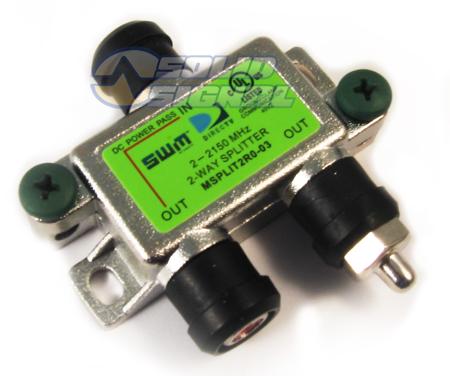A couple of weeks ago, I was perusing the internet when I came across this very question. I set about thinking of how you would do something like this. I also thought about why someone would want to do it.
First, the basic answer
Yes, it is technically possible. Here’s what you need to know:
In order to power a DIRECTV SWM dish using 12 volts, you’ll need to build something that simulates DIRECTV’s own power inserter. Specifically, it would need to supply 29 volts DC at 1.4 amps maximum through a coaxial cable. If what I just said there doesn’t make sense to you, this probably isn’t the right project for you. But if it does, you probably have all the information you need to get started.
The power supply you build has to be clean and consistent enough to power the equipment without introducing noise that might affect the satellite lines. It’s not impossible to do that, but it does take the kind of skill that few people today possess.
Connecting up your franken-power-supply
Once you have created something that steps the voltage up and supplies the required amperage, once it’s connected so it will output through a coaxial cable, you need to connect it to the system. You wouldn’t want to have the signal flow through your frankenpower setup. Instead, use one of these:

This DIRECTV Splitter passes power through one port and will let you inject the necessary voltage along the line. Connect the power supply to the red-centered port, on left in this photo It also introduces 3dB loss, but that shouldn’t be cause for alarm. You would be using a splitter like this anyway unless you were using the passthrough capability of DIRECTV’s power inserter. That device has a built-in splitter/injector which also introduces 3dB loss. In other words, you’re not losing any more signal than you were before.
If you are using more than one receiver, you can use a 4-port or 8-port version instead. Just remember that the power supply always needs to go into the port with the red center.
Here’s why I wouldn’t do this
It might be a fun thought experiment, but I wouldn’t do this in real life. The reasoning is simple: there’s too much to lose and too little to gain. You probably have a step-up transformer in your RV anyway to supply 110 volt power to other devices. The power inserter is going to draw a maximum of about 41 watts whether you start with 110 volt or 12 volt power. So, I have a hard time figuring out why making your own power supply would be a better solution.
DIRECTV’s own power supply is ready-built, tested, and reliable. It also allows you to preserve the original manufacturer warranty along the entire DIRECTV system. If you’re not powering your dish properly, you could create problems with the entire systems including the receivers. If there’s a problem, you might not be able to get the replacement you’d otherwise be entitled to.
Assuming you ended up building your own power supply out of scavenged cable and electrical parts, I don’t know honestly how well it would perform. You wouldn’t know that either. If you’re a master electrician, more power to you (pun intended.) You can probably build the best power supply there is. You might, or might not, spend more than the cost of a DIRECTV power inserter in the process.
The efficiency angle
In the forum post that inspired this article, it was suggested that you might want to do this because it’s more efficient if your RV is being powered by solar where every milliamp counts. I could definitely see that being true. Yet, I would also think that no matter what you would be stepping up voltage so you could use the RV’s 110 volt outlets. If you’re doing that anyway, I’m not sure there would be that much change in efficiency between going straight from 12 to 29 volts versus going up to 110 and back down to 29. Would it really make that much of a dent in the amount of usable electricity you have?
The great thing about being a DIYer is that you’re free to try these things, as long as you’re aware of the consequences. If it works for you, you’ve accomplished something really unique. There’s a lot of pride that comes with that. And of course, if that’s the direction you want to go, Solid Signal can help. Shop Solid Signal for all the parts you’ll need for your next DIY project. We have the parts and accessories that DIRECTV installers use, and you can use them too.





